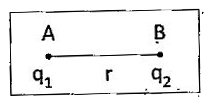State and explain Coulomb's inverse square law in electricity.
Text Solution
Coulomb.s Law : The force of:attraction or repulsion between two stationary charges is directly proportional to the product of the magnitudes of the two charges and is inversely proportional to square of the distance between them. This force acts along the line joining the two charges.

F∝q1q2 and F∝−1r2⇒F∝q1q2r2
F∝q1q2r2⇒F=14πε0q1q2r2ε0 is called permittivity of free space.
ε0=8.85×10−12Nm2/C2
This electrostatic force between the charges depends on the nature of the medium between them.
In any medium F=14πεq1q2r2ε is called permittivity of that medium.
FvaccuumFmed=εε0=εr=K
εr or k is called relative permittivity or dielectric constant. This force is an action and reaction pair i.e →F12=−→F21
In vector form of Coulomb.s law is →F12=14πεq1q2r212ˆr12=−→F21
|
Topper's Solved these Questions
- MODEL PAPER 5 BOOK - VGS PUBLICATION-BRILLIANTCHAPTER - MODEL PAPER 5 EXERCISE - SECTION-C
3 Videos
- MODEL PAPER 5 BOOK - VGS PUBLICATION-BRILLIANTCHAPTER - MODEL PAPER 5 EXERCISE - SECTION-C
3 Videos
- MODEL PAPER 3BOOK - VGS PUBLICATION-BRILLIANTCHAPTER - MODEL PAPER 3EXERCISE - SECTION - C
4 Videos
- MODEL PAPER 7BOOK - VGS PUBLICATION-BRILLIANTCHAPTER - MODEL PAPER 7EXERCISE - SECTION-C
3 Videos
Similar Questions
Knowledge Check
Assertion : Coulomb force and gravitational force follow the same inverse-square law.
Reason : Both laws are same in all aspects.AIf both assertion and reason are true and reason is the correct explanation of assertion.BIf both assertion and reason are true but reason is not the correct explanation of assertion.CIf assertion is true but reason is false.DIf both assertion and reason are false.Assertion : Coulomb force and gravitational force follow the same inverse-square law.
Reason : Both laws are same in all aspects.AIf both assertion and reason are true and reason is the correct explanation of assertion.BIf both assertion and reason are true but reason is not the correct explanation of assertion.CIf assertion is true but reason is false.DIf both assertion and reason are false.Inverse square law of distance is followed by
Agravitational forcesBelectromagnetic forcesCboth (a) and (b) aboveDneither (a) not (b)
State the limitation of Coulomb's law in electrostatics.
View SolutionState Coulomb's law.
View SolutionState Coulomb's law of force in electrostatics. Express it in vector form.
View SolutionState the Coulomb's Law. Write down its mathematical form.
View SolutionInverse square law of distance is followed by
View Solution
